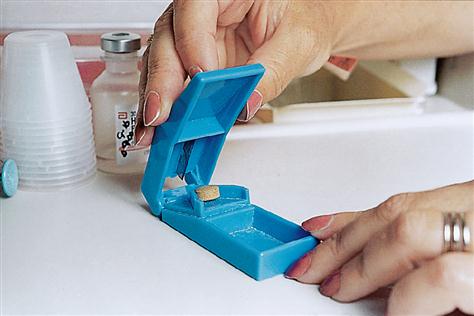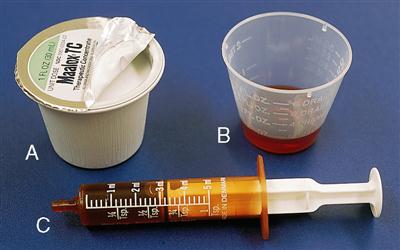Drug Measurements and Oral Dose Calculations
Introduction
Medications are ordered and supplied primarily in the metric system of measurement. This chapter teaches the application of basic mathematics, ratio and proportion, nursing process and critical thinking used in safe medication preparation. Mastery of this chapter will provide the reader with an excellent foundation for all drug dose calculations.
Metric System
The International System of Units (SI), which is commonly known as the metric system, is now being used exclusively in the United States Pharmacopeia. SI is the abbreviation for the French Système International d’Unités. The metric system is the preferred system for weights, volume, and lengths and is used in computers. It is the preferred system for medication administration.
The basic units are multiplied and divided by a multiple of 10 to form the entire system. Table 4-1 illustrates the relationships and values within the metric system. There are a few equivalents used frequently in medicine. These should be memorized and are as follows:
Table 4-1
Metric Measurements, Prefixes, and Their Values
| Prefix | Numerical Value | Power | Meaning | Example | Meaning |
| micro (mc) | 0.000001 | 10−6 | Millionth (10÷10,000,000) | microgram | one millionth of a gram |
| milli (m) | 0.001 | 10−3 | Thousandth (10÷10,000) | milliliter | one thousandth of a liter |
| centi (c) | 0.01 | 10−2 | Hundredth (10÷1000) | centimeter | one hundredth of a meter |
| deci (d) | 0.1 | 10−1 | Tenth (10÷100) | deciliter | one tenth of a liter |
| 1 | 10−0 | One (10÷10) | gram | one gram | |
| deka (da) | 10 | 10−1 | Tens (1 × 10) | dekagram | 10 grams |
| hecto (h) | 100 | 10−2 | Hundreds (10 × 10) | hectogram | 100 grams |
| kilo (k) | 1000 | 10−3 | Thousands (10 × 10 × 10) | kilogram | 1000 grams |
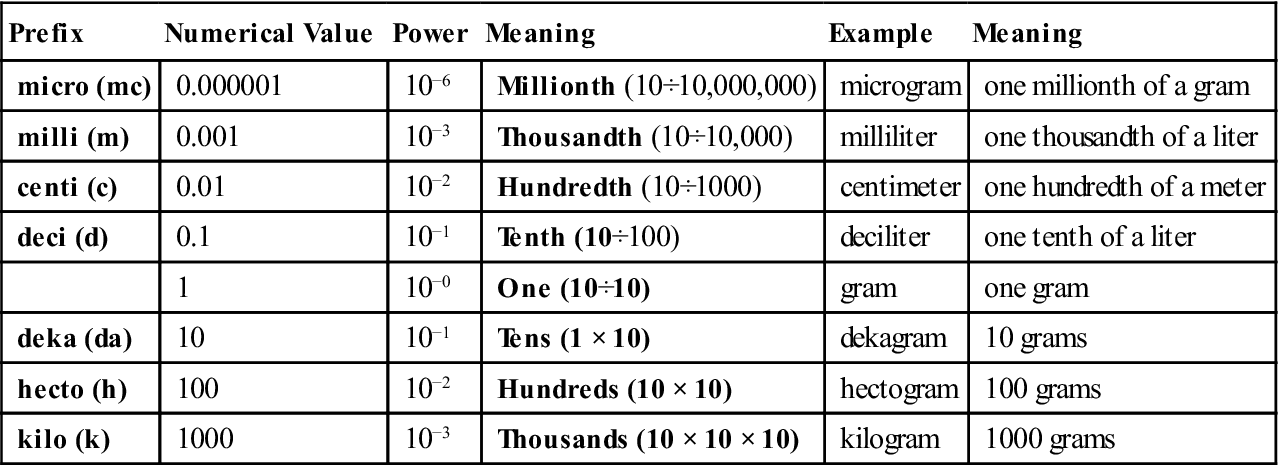
Note: The Numerical Value column illustrates that you are moving decimals to the right or the left, either multiplying by 10 or dividing by 10.
The amount of decimal movement depends upon the exponent (power). These prefixes can be combined with any metric base unit such as liters, meters, and grams. They can be seen in medication and scientific literature as well as in laboratory reports.
MEMORIZE
| * Weight | ||
| 1 mg (milligram) | = 1000 meg (micrograms) | |
| 1 g (gram) | = 1000 mg (milligrams) | |
| 1 kg (kilogram) | = 1000 g (grams) |
Volume
1 L (liter) = 1000 mL (milliliters)
remember
The abbreviation (such as g or mg) always follows the amount in the metric system. There is a space between the number and the abbreviation.
Examples
1000 mg
1 g
Examples
| Examples | Weight | Volume | Length |
| microgram (meg) | milliliter (mL) | millimeter (mm) | |
| milligram (mg) | deciliter (dL) | centimeter (cm) | |
| kilogram (kg) | liter (L) | meter (m) kilometer (km) |

 CLINICAL ALERT
CLINICAL ALERT
The nurse may encounter the symbol mgm for mg (milligram), µg for mcg (microgram), gm for g (gram), lowercase l for L (liter), and cc for mL (milliliter). Use the preferred highlighted symbols. The others have led to medication errors.
Metric Equivalents
The metric system is a decimal system.
remember
1000 mg = 1 g
1000 mcg = 1 mg
RULE
To convert grams (large) to milligrams (small), multiply by 1000.
Examples
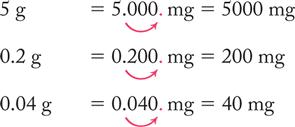
RULE
To convert milligrams (small) to grams (large), divide by 1000.
Examples

RULE
To convert milligrams (large) to micrograms (small), multiply by 1000.
Examples
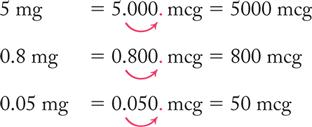
RULE
To convert micrograms (small) to milligrams (large), divide by 1000. Figure 4-1 illustrates the decimal movement.
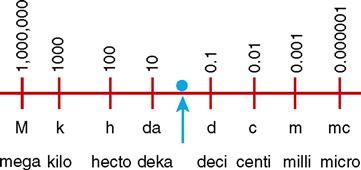
Examples
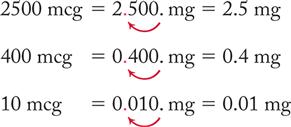
Fill in the following equivalents in the space provided:
remember
1 g = 1000 mg.
1 mg = 1000 mcg
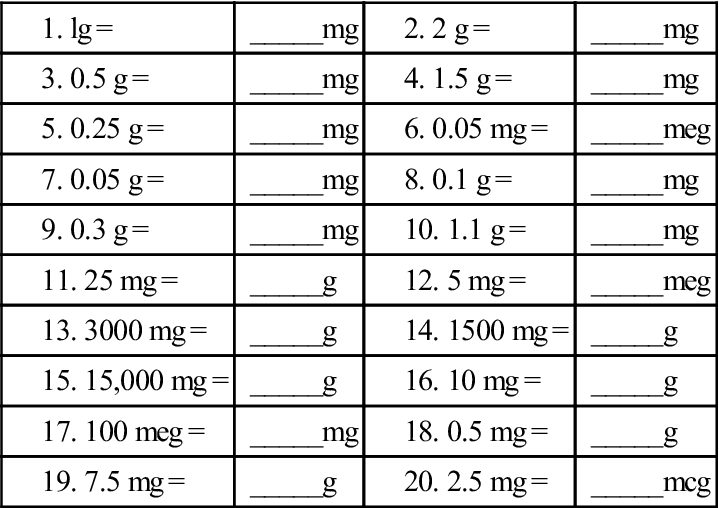
 CLINICAL ALERT
CLINICAL ALERT
The microgram, milligram, and gram are the most commonly used units of measurement in medication administration.
Medication tablets and capsules are most often supplied in milligrams. Antibiotics can be supplied in grams, milligrams, or units.* Micrograms are used in pediatrics and critical care cases for small doses and/or for powerful drugs, and the need to convert is frequent. You must be skilled in the measurement and conversion of all three units.
Rounding Medication Doses
RULE
Round your answers to the nearest measurable dose based on the selected equipment available and your patient’s condition after you verify that the dose is correct for that patient.
Example
| Example | Tablets: scored | Round to the nearest ½ tablet |
| 1.8 tabs | Give 2 tablets | |
| 1.5 tabs | Give 1.5 tablets | |
| 1.2 tabs | Give 1 tablet |
Tablets: unscored Do not break unscored tablets. Verify order. Recheck if the dose is more than 1 or 2 tablets. To break a “scored” tablet, use a pillcutter (Fig 4-2).
remember
Seldom does a patient receive more than one or two multiples of the drug unit dose supplied.
Rounding Milliliters
Examine the equipment you plan to use. On a syringe, the markings might be tenths or hundredths of a milliliter. On a larger syringe, markings might be in 0.2-mL increments.
Rounding to the Nearest Tenth
RULE
To round to the nearest tenth, examine the hundredths column. If it is 0.05 or greater, round up to the next tenth. If it is 0.04 or less, the tenths column remains the same.
Example
1.55 mL or 1.57 mL: Round to 1.6 mL
1.53 mL or 1.54 mL: Round to 1.5 mL
Ordered 1.75 mL. The 3-mL syringe shown below, the most commonly used syringe, is shaded to 1.8 mL, the nearest tenth, the nearest measurable dose.

Rounding to the Nearest Hundredth
RULE
To round to the nearest hundredth, examine the thousandths column. If it is 0.005 or greater, round up to the next hundredth.
Example
0.756: Round to 0.76
0.754: Round to 0.75

The 1-mL syringe is shaded to 0.75 mL because the 1-mL syringe is calibrated in hundredths and permits more exact measurement of small doses.*
Drops
• If an oral medication is to be administered, use the calibrated special spoon, prefilled syringe, or dropper provided (Figures 4-3 and 4-4) or draw it up in an appropriate syringe (without the needle) to the exact or nearest measurable amount.
RULE
Round to the nearest measurable calibration on the equipment you are using.
 CLINICAL ALERT
CLINICAL ALERT
To avoid overdosing the patient, never round up liquid medications to the nearest whole number. If the answer is 1.7 mL, DO NOT round up to 2 mL. Use a syringe with the appropriate calibrations to measure an exact dose.
One-Step Metric Ratio and Proportion Calculations
Ratio and proportion is a provable method of solving medication calculation problems. It can be used to calculate metric equivalents and medication doses with accuracy and logic. There are two types of metric one-step calculations: metric equivalent problems and metric dose problems.
Example
40 mg = ? g (metric equivalent problem)
RULE
Place the known metric equivalents from the metric tables on the left. Be sure to select the equivalents with the same terms as your problem (e.g., mg to g), and place the unknown on the right side of the equation in the same order as shown below.
Follow the same procedures as in Chapter 2 for ratio and proportion. Label all terms and prove your answer.

Example
Ordered: 50 mg. Unit dose on label: 25 mg per tab (medication dose problem)
The second example of common metric one-step ratio and proportion problems is this: Ordered: 50 mg. Label for the medicine: 25 mg per tab. Since both the order and the label are in the same terms—milligrams—this involves only a one-step calculation. It is now easy to estimate if you will be giving more or less than the drug concentration per tablet on hand.
RULE
Place what you have on hand or what you know (the label unit dose) on the left and what is ordered (want to have or know) on the right. Follow through with your math to verify your estimate as shown in the ratio and proportion examples in Chapter 2.

 CLINICAL ALERT
CLINICAL ALERT
Some of these problems can be easily solved without being written. However, it is safer to verify your answer using ratio and proportion. More complex problems will be more easily solved after practice with easier problems.
Use ratio and proportion to solve the following one-step metric equivalent problems. Prove and label all answers.
remember
| 1000 meg | = 1 mg | |
| 1000 mg | = lg | |
| 1000 g | = 1 kg (2.2 lb) | |
| 1000 mL | = 1 L (liter) |
Stay updated, free articles. Join our Telegram channel

Full access? Get Clinical Tree




